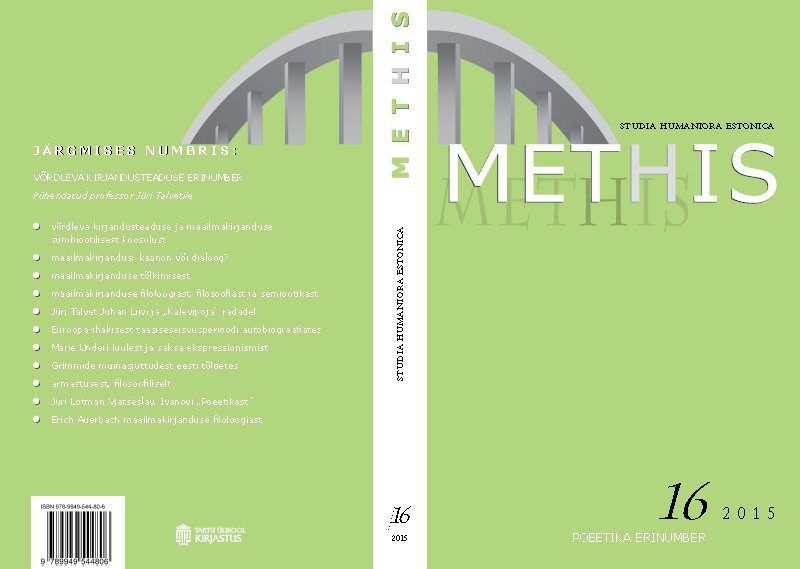Tõlkepoeetikast teksti ja keele taustal / On the Poetics of Translation
DOI:
https://doi.org/10.7592/methis.v13i16.12457Keywords:
tõlkimine, sisu ja vorm, poeetika, tekstianalüüs, intepreteerimine, translation, content and form, poetics, textual analysis, interpretationAbstract
Teesid: Artikkel käsitleb tõlkeprotsessi ilukirjandusliku teksti tõlkimisel, kus keeleline ja sotsiaalkultuuriline informatsioon on allutatud kunstilisele struktuurile. Et tekst ei kodeeri tähendust ühemõtteliselt, nõnda et seda saaks de- ja rekodeerida, rakendab tõlkija tähenduse lahti tinglikust keelemärgist ja vormistab selle teisiti, toetudes tekstis ära tuntud tugipunktidele. Tõlge on tõlkija intentsionaalne lausung, mis sõltub tema teadmistest ja kognitiivsest filtrist. Teoreetilise tõlkepoeetika rakendamist praktikas kirjeldab tõlkija Miriam McIlfatrick-Ksenofontov Jaan Malini luuletuse „Keele meel“ tõlkimise näitel.
S U M M A R Y
The article describes the process of translation in the light of Henri Meschonnic’s suggestion that the poetic compatibility of source text and target text is of central significance, not the differences between the languages and cultures involved. Departing from the premise that no text is determined by its linguistic or social contingencies, the goal of translation is to produce a new text that does in the new language what the original text does in the original language. The linguistic and cultural information of a source text is subject to its poetics.
In order to illustrate the practical implications of this approach, the article highlights translational solutions that cannot be explained in linguistic terms given that they attempt to maintain the specifics of the original. The translator proceeds by pretending to know what a text (and its author) is doing; it is the cognitive filter of the translator that gives the source text its meaning. In an account of her translation of Jaan Malin’s ”Keele meel“ into English, Miriam McIlfatrick-Ksenofontov begins with the analysis of the poem. This entails separating the whole into its component parts and identifying their relations. Reading with a view to translating unravels the texture of a poem, exposing the lexical, semantic and phonetic strands that constitute its coherence. The article then offers an account of how the translator experiences the original and navigates through it towards a new poem in translation, recognising that languages differ in what they can and must do. The latter, primarily a grammatical reality, is accompanied by a semantic one: the implications that stem from lexical connotations are inevitably different in the original poem and in the new poem. However, the supposed intent of the original is what a cognitive approach sees as a possibility of translation. This does not involve the transferral of isolated lexicalised items, but allows the translator to overcome the dilemma of retaining both form and content by adopting the role of writer, by working with language that is at no more at her disposal than it is for the writer of the original.
The analysis of the original enables the translator to avoid seeing the poem as fixed language in a solid object or searching for a single invariant meaning. Between the reader and the poem a situation of dialogue is established that involves asking questions of the poem in order to find what meanings it insists on. Questions like what does this word (image, rhyme, comma, etc.) do in/to the poem? how would the poem be different if this word (rhyme, etc.) were replaced by another or removed altogether? give the translator an idea of all the features that constitute a text; thus the use or absence of metre, form, layout, punctuation, lineation, rhyme, diction and syntax, etc. in the translation can be settled. Questions have to be directed not only at the denser parts of the poem, but even at those places where there seems to be univalence of meaning or standard language usage. Any detail or device, singly or together with another element(s), may be a hinge on which the poem turns. The guiding principle is that any choice made by the writer inevitably involved the rejection of alternatives. The elements on the page are both more and less than any answer anyone (translator or reader) can give. The objective is to interact with the text rather than wander aimlessly through the space that is opened up by reading.
In producing multiple drafts which explore and experiment with the devices employed in the original, the translator highlights the comprehensive set of values that account for its coherence. This, in turn, will test the translating language and its possibilities; the translating language may become subtly altered in the translation process, as the translator works under the influence of the syntactic and semantic systems of the original. There is an interdependence between imitation and creation in play here, which the translator explores. It is a process of synthesising, as the translator homes in on the most tenacious elements of the original and the expressive potential of her own language.
Reading a text generates conjectures that are infinite in number, but ultimately they will have to be tested against the text’s coherence. Translating with a focus on stylistic features as mental constructs rests on the claim that the mind stands between a word and its referent. By aiming to translate the mind rather than linguistic expression, a translator can discover options and make textually relevant choices between them.


